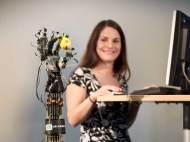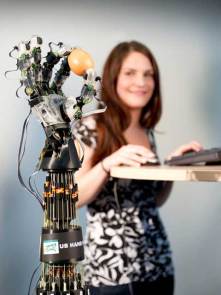Project DEXMART sensitive robotic hand
 Researchers at Saarland University together with associates in Bologna and Naples have developed a robotic hand that employs small electric motors to twist strings which mimic muscles in human body. Aside being powerful, the robotic hand is also delicate – making it useful to perform different tasks such as aid in your home or adding strength for rescuers in disaster scenarios.
Researchers at Saarland University together with associates in Bologna and Naples have developed a robotic hand that employs small electric motors to twist strings which mimic muscles in human body. Aside being powerful, the robotic hand is also delicate – making it useful to perform different tasks such as aid in your home or adding strength for rescuers in disaster scenarios.
“We wanted to impart our robotic hand with a broad spectrum of human traits. Its artificial muscles should be able to deliver enormous forces by simple and compact means”, said Chris May, scientist at Saarland University’s Laboratory of Actuation Technology. “We came up with a simple, yet extremely effective idea: using strings that are twisted by small, high-speed motors, we are able to exert high tensile forces within a compact space.”
Equipped with sensors and advanced control algorithms, the developed robotic hand is able to manipulate with diverse objects, to grasp and lift them and delicately move them to a new position. These actions are enabled by mini electric motors able to run at high speed and a small torque (order of five Newton-millimeters). Combined with extremely strong polymer strings, the motors enable the robotic hand to lift a 5 kilogram (11 lbs) load by 30 mm (1.2″) within a split second.
“Each robotic finger, which like a human finger is comprised of three segments, can be controlled precisely by means of the individual tendons”, said May. “The capability of the robotic hand is so near to that of humans that the vision of robots as personal assistants in the household, in the operating room as well as in industrial settings is becoming ever more realistic. We presume that the combination of small electric motors with twisted string is interesting for other applications as well.”
The development of the robotic hand is a part of the European project DEXMART – where an international group of scientists from eight universities and research institutes in Germany, France, Italy and Great Britain, worked over the past four years to develop various concepts that were mainly focused on improving the versatility of robotic arms.
The robotic hand was recently presented during a meeting at the Forschungszentrum Informatik (Research Center for Information Technology) in Karlsruhe, where May demonstrated the abilities of the arm where it handled a delicate Easter egg and a heavy glass bottle. As a complement to this research, other DEXMART research teams addressed topics of programming by demonstration, object grasping and manipulation as well as human-robot interaction.










Leave your response!